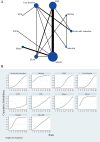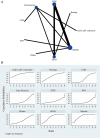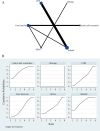Comparative efficacy of six types of scoliosis-specific exercises on adolescent idiopathic scoliosis: a systematic review and network meta-analysis
- PMID: 39725973
- PMCID: PMC11670383
- DOI: 10.1186/s12891-024-08223-1
Comparative efficacy of six types of scoliosis-specific exercises on adolescent idiopathic scoliosis: a systematic review and network meta-analysis
Abstract
Background: Adolescent idiopathic scoliosis (AIS) stands as the predominant spinal deformity in adolescents, manifesting symptoms including back pain, functional limitations, cosmetic worries, and respiratory dysfunction. At present, six approaches of scoliosis-specific exercises are globally practiced, encompassing Schroth exercise, the Scientific Exercise Approach to Scoliosis (SEAS), the Dobomed, the side shift exercise, active self-correction, and the Functional Individual Therapy of Scoliosis (FITS). However, there is no systematic review and meta-analysis comparing the efficacy of these six types of scoliosis-specific exercises on adolescent idiopathic scoliosis.
Objective: To evaluate and compare the efficacy of six types of scoliosis-specific exercises on spinal deformity and quality of life in AIS.
Materials and methods: A systematic search was performed on PubMed, EMBASE, and the Cochrane Library from their inception to September 2023. Two independent auditors screened all studies according to predefined inclusion and exclusion criteria. Clinical trials were compiled to investigate the effects of six exercise interventions on spinal deformity and quality of life in AIS.
Results: Twenty-four studies were included, with a sample size of 1069 subjects. After meta-analysis, it was shown that SEAS ranked first in reducing Cobb angles (SUCRA: 84.8%); active self-correction and Schroth significantly improved the angles of trunk rotation in AIS (SUCRA: 86.6% and SUCRA: 79.1%, respectively); active self-correction and Schroth showed significant improvements in quality of life (SUCRA: 76.6% and SUCRA: 76.0%, respectively).
Conclusion: According to the current findings, active self-correction demonstrated superior short-term benefits compared to other exercise interventions in ameliorating spinal deformity and improving quality of life for adolescents with idiopathic scoliosis. Meanwhile, Schroth exhibited long-term effects in improving both spinal deformity and quality of life.
Registration information: This review was registered on PROSPERO on June 20, 2023 (ID: CRD42023433152).
Keywords: Exercise; Meta-analysis; Scoliosis; Systematic review.
© 2024. The Author(s).
Conflict of interest statement
Declarations. Ethics approval and consent to participate: This is a systematic review. The First Affiliated Hospital of Xinxiang Medical University Research Ethics Committee has confirmed that no ethical approval is required. Informed consent was obtained from all individual participants included in this study. Consent for publication: Not applicable. Competing interests: The authors declare no competing interests.
Figures




Similar articles
-
Systemic pharmacological treatments for chronic plaque psoriasis: a network meta-analysis.Cochrane Database Syst Rev. 2021 Apr 19;4(4):CD011535. doi: 10.1002/14651858.CD011535.pub4. Cochrane Database Syst Rev. 2021. Update in: Cochrane Database Syst Rev. 2022 May 23;5:CD011535. doi: 10.1002/14651858.CD011535.pub5. PMID: 33871055 Free PMC article. Updated.
-
Effectiveness of Schroth exercises for adolescent idiopathic scoliosis: a meta-analysis.PeerJ. 2025 Jul 8;13:e19639. doi: 10.7717/peerj.19639. eCollection 2025. PeerJ. 2025. PMID: 40656945 Free PMC article.
-
Effects of Schroth method and core stabilization exercises on idiopathic scoliosis: a systematic review and meta-analysis.Eur Spine J. 2022 Dec;31(12):3500-3511. doi: 10.1007/s00586-022-07407-4. Epub 2022 Oct 14. Eur Spine J. 2022. PMID: 36229615
-
The Superiority of Schroth Exercise Combined Brace Treatment for Mild-to-Moderate Adolescent Idiopathic Scoliosis: A Systematic Review and Network Meta-Analysis.World Neurosurg. 2024 Jun;186:184-196.e9. doi: 10.1016/j.wneu.2024.03.103. Epub 2024 Mar 24. World Neurosurg. 2024. PMID: 38531472
-
Physiotherapeutic Scoliosis-Specific Exercise for the Treatment of Adolescent Idiopathic Scoliosis: A Systematic Review and Network Meta-analysis.Am J Phys Med Rehabil. 2024 Jan 1;104(1):14-25. doi: 10.1097/PHM.0000000000002524. Epub 2024 May 10. Am J Phys Med Rehabil. 2024. PMID: 38726971
Cited by
-
Evaluating exercise therapies in adolescent idiopathic scoliosis: a systematic review with Bayesian network meta-analysis.PeerJ. 2025 Mar 31;13:e19175. doi: 10.7717/peerj.19175. eCollection 2025. PeerJ. 2025. PMID: 40183057 Free PMC article.
-
The efficacy of core stabilization exercise in mild and moderate adolescent idiopathic scoliosis: a systematic review and meta-analysis.J Orthop Surg Res. 2025 Feb 28;20(1):214. doi: 10.1186/s13018-025-05612-7. J Orthop Surg Res. 2025. PMID: 40016756 Free PMC article.
References
-
- Weinstein SL, Dolan LA, Cheng JC, Danielsson A, Morcuende JA. Adolescent idiopathic scoliosis. Lancet (London England). 2008;371(9623):1527–37. - PubMed
-
- Negrini S, De Mauroy JC, Grivas TB, Knott P, Kotwicki T, Maruyama T, et al. Actual evidence in the medical approach to adolescents with idiopathic scoliosis. Eur J Phys Rehabil Med. 2014;50(1):87–92. - PubMed
-
- Lenssinck ML, Frijlink AC, Berger MY, Bierman-Zeinstra SM, Verkerk K, Verhagen AP. Effect of bracing and other conservative interventions in the treatment of idiopathic scoliosis in adolescents: a systematic review of clinical trials. Phys Ther. 2005;85(12):1329–39. - PubMed
-
- Altaf F, Gibson A, Dannawi Z, Noordeen H. Adolesc Idiopathic Scoliosis. 2013;346:f2508. - PubMed
-
- Morrissy RT, Goldsmith GS, Hall EC, Kehl D, Cowie GH. Measurement of the Cobb angle on radiographs of patients who have scoliosis. Evaluation of intrinsic error. J bone Joint Surg Am Volume. 1990;72(3):320–7. - PubMed
Publication types
MeSH terms
Grants and funding
- LHGJ20220609/The Medical Science and Technology Research Program Joint Construction Project of Henan Province
- LHGJ20220609/The Medical Science and Technology Research Program Joint Construction Project of Henan Province
- LHGJ20220609/The Medical Science and Technology Research Program Joint Construction Project of Henan Province
- (QN-2022-A13/the Youth Cultivation program of The First Affiliated Hospital of Xinxiang Medical University
- (QN-2022-A13/the Youth Cultivation program of The First Affiliated Hospital of Xinxiang Medical University
LinkOut - more resources
Full Text Sources
Medical

